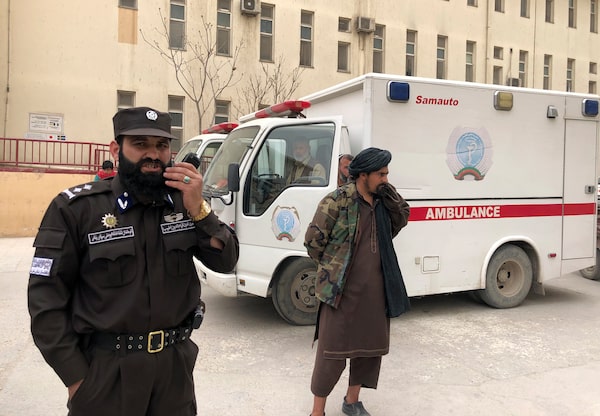
Taliban fighters stand guard outside the hospital after a bomb blast in Mazar-e Sharif, the capital city of Balkh province, in northern Afghanistan, on March 9. A bomb killed a Taliban-appointed provincial governor and two others in Mazar-e-Sharif , a Taliban police spokesman said.Abdul Saboor Sirat/The Associated Press
Ruchi Kumar is an Indian journalist based in Mumbai who covers south Asia.
In April, 2020, after years of inter-governmental efforts, Ejaz Amin Ahangar – a dreaded leader of the Islamic State regional affiliates in south Asia – was captured in Kandahar province by the Afghan National Directorate of Security. Mr. Ahangar, an Indian national, had been wanted for his role in terrorist activities in Kashmir and Afghanistan, including for the brutal 2020 attack on a Sikh temple in Kabul that led to the deaths of 25 worshippers, an act claimed by Islamic State Khorasan Province (ISKP), a regional arm of the Islamic State.
Just over a year later, Mr. Ahangar was free again, thanks to an unexpected jail break orchestrated by the Taliban – a decision that the Taliban now surely regret.
As the Taliban’s fighters took over province after province on their march to Kabul in 2021, they took over government prisons, releasing not only captive members of their own ranks, but also convicted criminals, insurgent allies, and other militants such as Mr. Ahangar.
But neither he nor any of the thousands of IS militants released by the Taliban were the group’s allies. Since the ISKP first took root in Afghanistan in 2015, it has fought the now-collapsed foreign-backed Afghan government and the now-ruling Taliban alike. The ISKP has recruited aspiring insurgents from the south Asian subcontinent who had flocked to Afghanistan, where joining the Islamic State’s cause was more accessible.
However, the group largely remained on the fringe of militant activities before 2021, owing to the collective efforts of international and Afghan security officials who managed to keep the insurgency in check, if not entirely eradicated. In April, 2017, the U.S. military even dropped a Massive Ordnance Air Blast (MOAB) on Nangarhar province’s Achin district, which had become a hotbed of ISKP activity. Toward the end of 2020, more than 2,000 ISKP foreign fighters were in Afghan prisons, with another 3,000 to 4,000 estimated to be operating within Afghanistan.
All of this changed dramatically after the Taliban’s unceremonious seizure of power, which created a vacuum within the country’s security infrastructures and has allowed foreign militancy to thrive again in Afghanistan.
Within days of their 2021 release, ISKP militants launched several attacks, including the suicide bombing at the Kabul airport that killed at least 170 Afghans and 13 U.S. soldiers during the chaotic evacuation efforts in August, 2021. In the year-and-a-half since, ISKP has conducted dozens of attacks that have largely targeted religious and ethnic minorities in Afghanistan, but the group has also taken aim at the Taliban, which it sees as less fundamentalist and allied with the west. Earlier this month, an ISKP suicide bomber killed Mohammad Dawood Muzammil, the governor of Balkh province and a key leader of the Taliban movement. The Islamic State has effectively become to the Taliban what they once were to the previous foreign-backed government: a threat to national and regional stability, at the cost of Afghan lives.
For their part, the Taliban have been fighting to control the ISKP insurgencies and have had some success. Mr. Ahangar, along with the ISKP’s intelligence and operations chief Qari Fateh, were killed in an operation conducted in February in Kabul. However, despite the few victories, the Taliban are faced with the same problems as any government trying to suppress terrorist activities.
But unlike most other governments, they are isolated in their counterterrorism efforts, owing to their own history of human rights violations and their support of terror groups, which has inspired no confidence in their abilities. The U.S.’s latest Country Report on Terrorism, which was released last month, noted that the Taliban’s ability to prevent al-Qaeda and ISKP operations “remained unclear.” The lack of faith was further proven out by a U.S. drone strike that killed al-Qaeda chief Ayman al-Zawahiri in Kabul last July.
The Taliban is unlikely to attract any allies in its fight against ISKP while it continues to serve as a patron for other insurgent and criminal groups. On their own, they lack the capacities to rein in the growing insurgencies of groups with vast resources and large stocks of foreign fighters.
But this is a problem for the West, too. Analysts watching Afghanistan have warned that the Taliban’s failure could turn Afghanistan into fertile ground for terrorist groups looking for rent-free, lawless real estate from where they can target other countries. As the U.S. terrorism report noted: “Instability and potential terrorist activities emanating from Afghanistan became a serious concern for the country’s neighbors, as they worried about spillover effects from the conflict and instability.”
The conflict in Afghanistan has moved into a new phase, and the Taliban appear to be in over their heads. In this case, that is not a good thing.